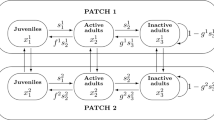Abstract
As the result of the complexity inherent in nature, mathematical models employed in ecology are often governed by a large number of variables. For instance, in the study of population dynamics we often deal with models for structured populations in which individuals are classified regarding their age, size, activity or location, and this structuring of the population leads to high dimensional systems. In many instances, the dynamics of the system is controlled by processes whose time scales are very different from each other. Aggregation techniques take advantage of this situation to build a low dimensional reduced system from which behavior we can approximate the dynamics of the complex original system.
In this work we extend aggregation techniques to the case of time dependent discrete population models with two time scales where both the fast and the slow processes are allowed to change at their own characteristic time scale, generalizing the results of previous studies. We propose a non-autonomous model with two time scales, construct an aggregated model and give relationship between the variables governing the original and the reduced systems. We also explore how the properties of strong and weak ergodicity, regarding the capacity of the system to forget initial conditions, of the original system can be studied in terms of the reduced system.
Similar content being viewed by others
REFERENCES
Berman, A. and R.J. Plemmons (1979). Nonnegative matrices in the mathematical sciences. Academic Press, San Diego.
Blasco, A., L. Sanz, P. Auger and R. Bravo de la Parra (2001). Linear Discrete Population Models with Two Time Scales in Fast Changing Environments I: Autonomous Case. Acta Biotheoretica 49: 261-276.
Caswell, H. (2001). Matrix population models. Sinauer Associates Inc., Sunderland, Massachusetts.
Charlesworth, B. (1994). Evolution in age-structured populations. Cambridge University Press, Cambridge. 306pp.
Cohen, J.E. (1979a). Ergodic theorems in demography. Bulletin of the American Mathematical Society 1: 275-295.
Cohen, J.E. (1979b). Contractive inhomogeneous products of non-negative matrices. Mathematical Proceedings of the Cambridge Philosophical Society 86: 351-364.
Golubitsky, M., E.B. Keeler and M. Rothschild (1975). Convergence of the age structure: applications of the projective metric. Theoretical Population Biology 7: 84-93.
Hajnal, J. (1976). On products of non-negative matrices. Mathematical Proceedings of the Cambridge Philosophical Society 79: 521-530.
Kim, Y.J. and Z. M. Sykes (1976). An experimental study of weak ergodicity in human populations. Theoretical Population Biology 10: 150-172.
López, A. (1961). Problems in Stable Population Theory. Princeton University Press, Princeton, NJ.
Quinn, T.J. (1981). The use of Leslie type age-structured models for the pacific halibut population. Quantitative Population Dynamics, D.G. Chapman and F. Galluci (eds), 217-242.
Sanchez, E., R. Bravo and P. Auger (1995). Linear discrete models with different time scales. Acta Biotheoretica 43: 465-479.
Sanz, L. and R. Bravo de la Parra (1998). Variables aggregation in time varying discrete systems. Acta Biotheoretica 46: 273-297.
Sanz, L. and R. Bravo de la Parra (1999). Variables aggregation in a time discrete linear model. Mathematical Biosciences 157: 111-146.
Sanz, L. and R. Bravo de la Parra (2000). Time scales in stochastic multiregional models. Nonlinear Analysis: Real World Applications 1: 89-122.
Sanz, L. and R. Bravo de la Parra (2001). Time scales in a non autonomous linear discrete model. Mathematical Models and Methods in Applied Sciences (accepted).
Seneta, E. (1981). Non-negative matrices and Markov chains. Springer Verlag, New York. 279pp.
Skellam, J.G. (1967). Seasonal periodicity in theoretical population ecology. Proceedings of the 5th Berkeley Symposium in Mathematical Statistics and Probability Vol. 4: 179-205, Univ. of California Press, Berkeley.
Author information
Authors and Affiliations
Corresponding author
Rights and permissions
About this article
Cite this article
Blasco, Á., Sanz, L., Auger, P. et al. Linear Discrete Population Models with Two Time Scales in Fast Changing Environments II: Non-Autonomous Case. Acta Biotheor 50, 15–38 (2002). https://doi.org/10.1023/A:1014753026569
Issue Date:
DOI: https://doi.org/10.1023/A:1014753026569




